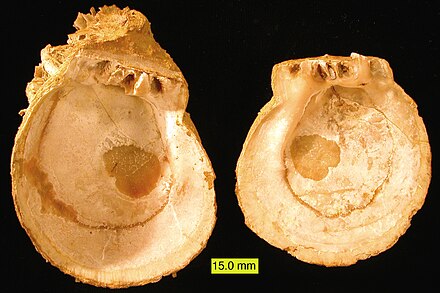Spondylus
Spondylus is a genus of bivalve molluscs, the only genus in the family Spondylidae. They are known in English as spiny oysters (though they are not, in fact, true oysters).
The many species of Spondylus vary considerably in appearance. They are grouped in the same superfamily as the scallops.
They are not closely related to true oysters (family Ostreidae); however, they do share some habits such as cementing themselves to rocks rather than attaching themselves by a byssus. The two halves of their shells are joined with a ball-and-socket type of hinge, rather than with a toothed hinge as is more common in other bivalves. They also still retain vestigial anterior and posterior auricles ("ears", triangular shell flaps) along the hinge line, a characteristic feature of scallops, though not of oysters.
As is the case in all scallops, Spondylus spp. have multiple eyes around the edges of their mantle, and they have relatively well-developed nervous systems. Their nervous ganglia are concentrated in the visceral region, with recognisable optic lobes connected to the eyes.
The genus Spondylus appeared in the Mesozoic era, and is known in the fossil records from the Triassic Cassian beds in Italy (235 to 232 million years ago) onwards. About 40 extinct species are known.[3]
Fossils of these molluscs can be found in fossiliferous marine strata all over the world. For example, they are present in Cretaceaous rocks in the Fort Worth Formation of Texas, and in the Trent River Formation of Vancouver Island, as well as in other parts of North America.[4][5]





